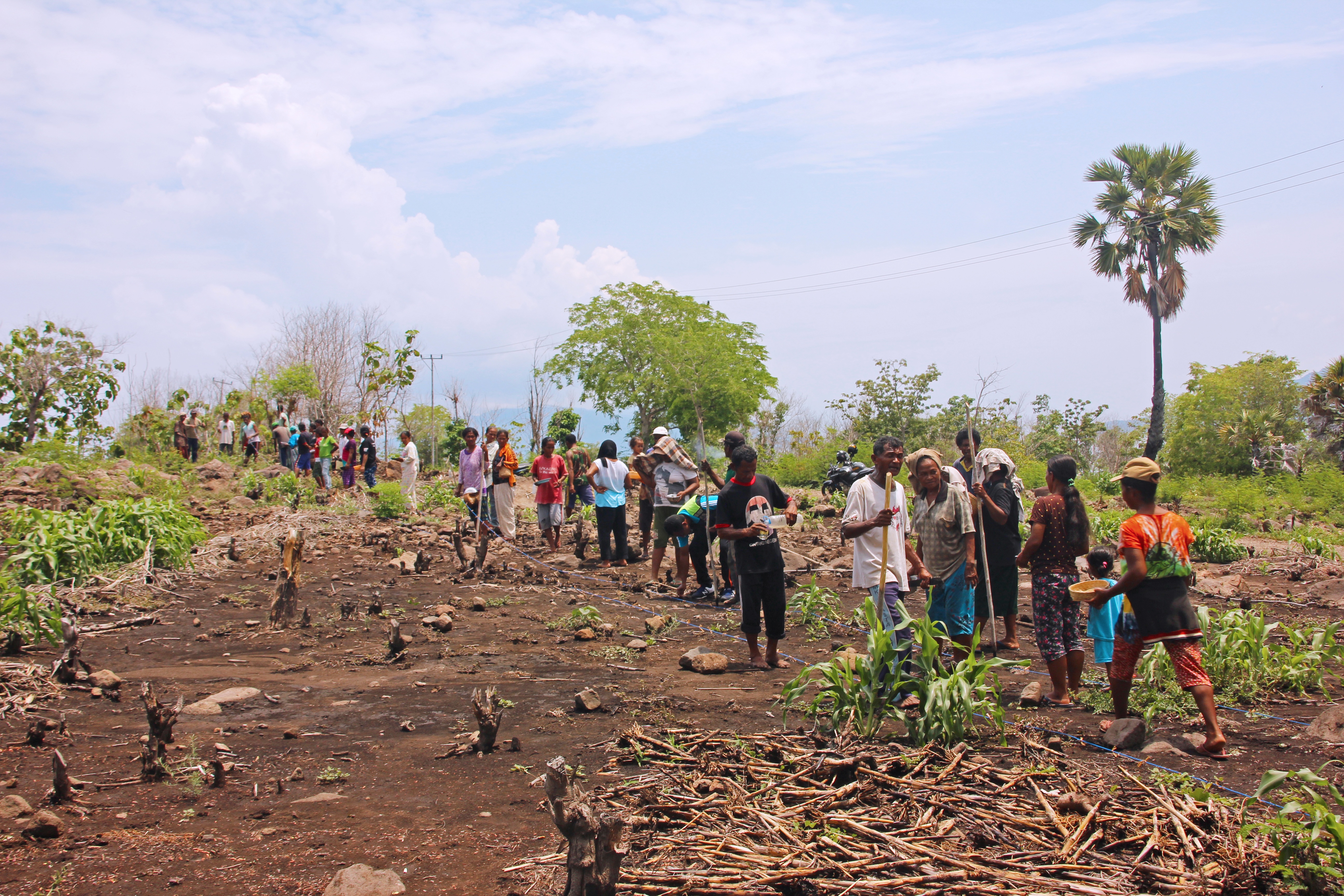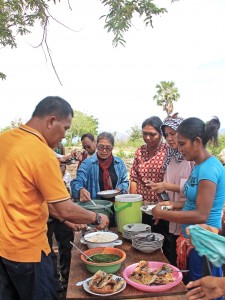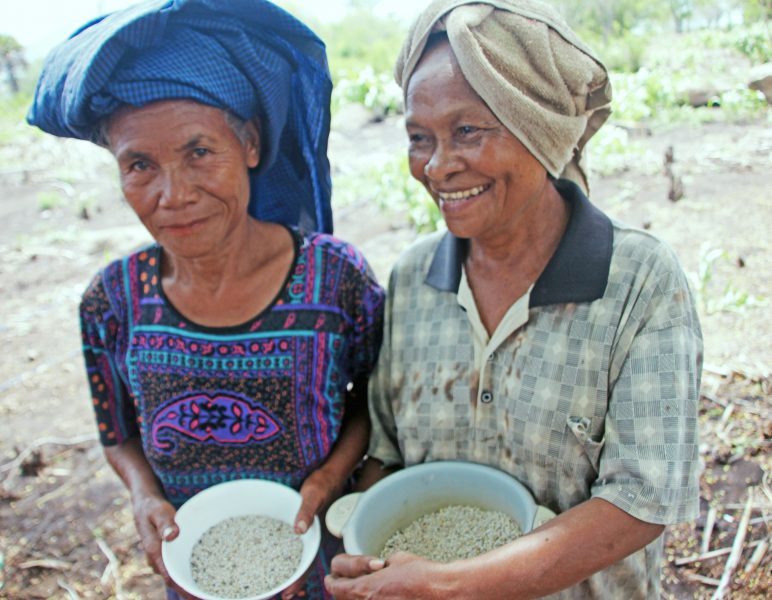Sorghum is a gluten-free and nutrient-rich crop that can replace rice in times of need. It is drought-resistant and grows where the soil cannot produce vegetables.
Cruising down the coastal roads of Larantuka, it is impossible not to notice an air of prayer in the sweet whispers of the sea waves. It is difficult to forget the sights and sounds of icon-studded flower gardens, Stations of the Cross, and chapels where Hail Marys are chanted in Portuguese. Every Easter weekend, the Semana Santa processions draw thousands of foreign and Indonesian pilgrims to this historical Eastern Flores town.
It is rather ironic how this green Catholic oasis can resemble a desert when it comes to agricultural life. Toiling on “soily rocks” (not rocky soil, the locals corrected me) with scarce water supply, farmers in Eastern Flores are no strangers to adversities like crop failure and famine.
It takes real bravery to abandon a comfortable city life that a legal career can provide, and become a farmer in East Flores. During the Southeast Asian monetary crisis in 1997, Maria Loretha and her family left Malang in East Java to live in Pajinian, her husband’s village in Larantuka’s neighbouring island of Adonara – administratively part of East Flores. Today, 48-year-old Loretha is best known as “Mama Sorghum,” a champion of East Flores’s forgotten wonder crop.
Originally a Kanayatn Dayak-woman from West Kalimantan, Loretha came to East Flores as a 28-year-old mother with a Bachelor of Law and no experience in agriculture. Growing brown rice and legumes in her husband’s arid plot was a daunting mission.
But through her persistence in embracing the challenge, Loretha discovered how life-giving East Flores’s desolate landscapes can be. To unleash that natural potential, it takes a mind that’s open to learning how the land works, and agricultural strategies that cater to the land’s characteristics.
Unlike in Java, growing wet rice fields in East Flores is excruciatingly difficult. But East Flores yields a diverse assortment of nutritious crops: sorghum, barley, millet, maize and plantain. Regarded as “inferior,” these crops are usually grown as animal fodder and back-up staples in anticipation of rice scarcity in the dry season.

The greater challenge to growing crops is changing mindsets shaped by decades of government policies pushing for the expansion of mass-producing rice fields, and the cultural shaming that perceive eaters of “inferior crops” as “poverty-stricken.”
Loretha fondly remembers her first encounter with the humble sorghum in 2007. As a token of gratitude, Maria Helan – a financially struggling widow Loretha took care of – cooked for her a traditional sorghum dish with grated coconut. Delighted by the novelty, Loretha spent the coming years in search of native sorghum seeds and advocating a sorghum revival among East Flores farmers.
Loretha later learned that sorghum is versatile, gluten free, high in protein and fibre and tends to be more filling than rice. Men’s Fitness named it among “Five Healthy Whole Grains You’ve Never Heard Of.” The Guardian dubbed it “the new wonder grain” that quinoa lovers should watch out for.
“Sorghum was not widely grown as a domestic crop in 2007. Back then it grew in the wild,” recalled Loretha. “Since the 1970s, East Flores has been invaded with commercially bred seeds of rice and maize. Wet rice field-based agriculture was enforced throughout the Suharto era. But the government also supported farmers with funding and post-harvest tools, as well as campaigns promoting white rice as ‘healthy food.’”
Evidently, East Flores does not have the wetlands to support Jakarta’s misleading “healthy rice” propaganda.
“Once Indonesia runs out of healthy wetlands, we become dependent on imported rice from Vietnam and Cambodia,” said Loretha. And yet many Indonesians would rather go into debt to have white rice for dinner, rather than eat readily available nutritious ‘animal fodder’ like sorghum or maize.
Likotuden – an hour’s drive from Larantuka on mainland Flores – is one of those arid villages where the soil is too poor to grow most vegetables, and rice crop failure happens frequently. However, two prized superfoods thrive there: the drought-resistant sorghum and the highly nutritious moringa.
Since 2007, Loretha has been working with Kehati Foundation and the Diocese of Larantuka to assist farmers in Likotuden to organically domesticate these local superfoods. Communities are encouraged to adopt sorghum as their primary daily staple rather than backup food during famines. The sorghum initiative has since expanded to Adonara, Lembata, Ende, West Flores and East Sumba.
“This initiative has also been a great opportunity to revive local agricultural narratives,” added Loretha. The East Flores folklore of Ema Hingi Nogo Gunu tells of a woman who sacrificed her life to feed her seven brothers during a famine. Ema Hingi Nogo Gunu’s blood transformed into maize, her intestines into barley, her flesh into dry rice paddies and her bones into sorghum.
“The agricultural philosophy of East Flores layered intercropping is embedded in this folklore,” explained Loretha. Taro and barley are grown in the outermost layer, followed by maize and dry rice paddies. “Like the seven brothers of Ema Hingi Nogo Gunu, these crops serve as the guardians of the sorghum. They’re grown in the innermost layer, most protected from pests such as boars and birds.”
Loretha’s vision earned her the Washington DC-based Ashoka Social Entrepreneurship Global Fellowship in 2013.
“To champion sorghum is to support the government’s fight against malnutrition and to provide hope for better livelihoods for rural Indonesians,” said Loretha. “It spells hope for desolate-looking lands that could in fact yield sorghum to feed many. It spells hope for women to not have to become migrant workers and have their families torn apart just to afford a sack of rice. If family barns in Flores prosper with abundantly available nutritious food, it means so much more than money.”
East Flores farmers assisted by Loretha currently supply sorghum flour for the Unis Gluten Free Bakery in Bogor. They recently terminated a collaboration with Javara – a premium indigenous food brand sold in high-end supermarkets – due to the prohibitive costs of sustaining business within the brand. Loretha said her farmers plan to expand their offerings of sorghum-based products and cater to an international market in the future. “But currently, establishing food sovereignty at home remains our priority,” she concluded.
Loretha is happy to arrange sorghum tours and tastings in Likotuden and other sorghum-growing communities assisted by the Diocese of Larantuka. She can be contacted on +62-852-3888-0085.
Fast Facts
Country: Indonesia
Province: Nusa Tenggara Timur (NTT)
Land area: 1,813 square kilometres (East Flores regency, including mainland
Flores, Adonara and Solor)
Largest city: Larantuka (East Flores regency)
Population: 251,820 (2014 estimate of East Flores regency)
How to get there: Flights into international airport at Kupang
Flights from Kupang to Larantuka
What to bring: Camera, hat, sunscreen, insect repellent, good walking shoes.
If staying in the village, bring a flashlight, extra batteries, power bank, and a no-frills cellphone (non-smartphone).
Gifts of coffee, tea, and sugar for your hosts are much appreciated.
Buy bottled water, hand sanitizer and trash bags in Larantuka.
Cash for transactions – draw cash in Larantuka.




